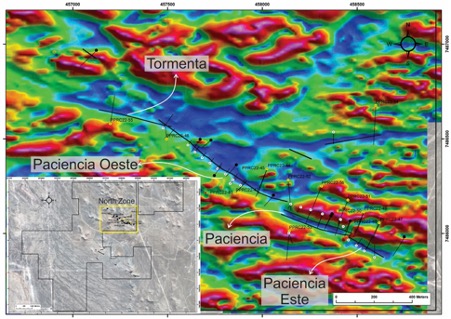Astra Exploration Inc. (TSXV: ASTR) has completed 3,976 metres of RC drilling in 15 holes at its Pampa Paciencia Project located in Northern Chile.
Highlights
- 100% of holes intersected quartz veins, stockworks or veinlets close to target depths
- 11 holes were drilled to expand mineralization beneath the Phase I programme
- Four holes into blind geophysical targets including the newly discovered Tormenta Vein
- Tormenta Vein is a splay off the main Paciencia Vein with two holes returning six and 28 metre-wide downhole intervals (5 and 10 metres estimated true widths, respectively)
“The Phase II drilling programme has delivered a significant increase in vein strike from 1.4 to 2.1 kilometres with the discovery of new veins including the Tormenta Vein,” CEO, Brian Miller, said.
“The continuity of veins in the Paciencia Vein System was confirmed at depths of 100 metres below previous drilling, where company geologists believe some of the best drill targets exist, and further confirms our view that we are only just starting to define the mineralised footprint of the Paciencia Vein Field. Further, Astra’s team has completed another campaign of drilling on time and budget with an estimated all-in drill cost of approximately C$200 per metre.”
Drilling Details
The Phase II programme consisted of 3,976 metres of RC drilling in 15 holes, all in the North Zone target area.
The primary focus was to test the Paciencia Vein System at depth in the two defined high-grade zones defined earlier this year in the Phase I drill programme.
Eleven holes were drilled into known veins, with four holes directed to Paciencia Oeste vein segment, three to Paciencia and four to Paciencia Este segment.
Drill results from the Phase II programme confirm the continuity of the quartz veins at depth in the Paciencia Vein System, which is a low-sulphidation epithermal (LSE) vein structure averaging 10 to 15 metres thickness over a strike length of approximately 1.4 kilometres. Some deeper holes in the Paciencia and Paciencia Este vein segments are showing a change in the dip and thickness of the vein.
Secondary targets consisted of other vein structures discovered during the Phase I drill programme. These include blind magnetic low anomalies and newly interpreted vein structures from other geophysical targets, in particular WNW, E-W to ENE-striking magnetic lineaments related with low magnetic regional anomalies.
All holes intersected quartz veins, stockworks or veinlets at depth in agreement with the magnetic low anomalies. A new WNW-ESE vein (Tormenta vein) was intersected in hole PPRC22-46 with a 28 metre-thick downhole interval (10 metres estimated true width) and is interpreted to extend west to a six metre-thick downhole interval (five metres estimated true width) at hole PPRC22-55. Hole PPRC22-54 intersected quartz veinlets and is interpreted to extend west to hole PPRC-22-38 (discovered in Phase I) in a new ENE-WSW vein structure.
For further information please visit: https://astra-exploration.com/












